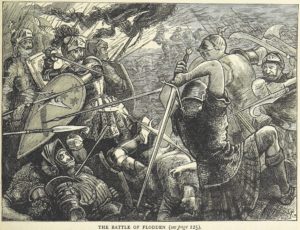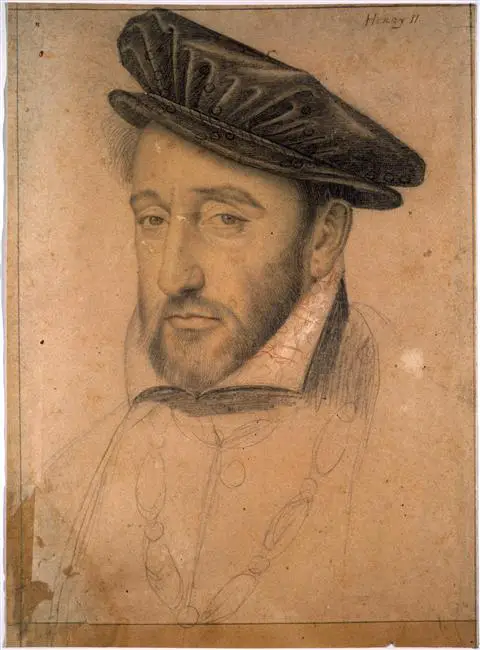 Thank you to Tudor Society member Jeffrey for asking the following question:
Thank you to Tudor Society member Jeffrey for asking the following question:
"I have a fascination to learn by whom, how and to what extent the battlefields of Bosworth, Flodden, Stoke Field and others were cleared in the aftermath. What happened to what was left - carnage, the armour, horses, weapons, personal effects and of course the bodies?"
Our military historian Julian Humphrys of the Battlefields Trust has answered the question. A big thank you to him!
In general terms it was very much a case of ‘to the victor, the spoils’ with the army left in possession of the field at the end of a battle having the pick of whatever remained there. Indeed, battles of the Medieval and Tudor periods were frequently followed by an intense period of clearing up with everything of potential value being taken by the winners. There was nothing particularly new in this – the lower section of the Bayeux Tapestry shows little men gathering up swords and stripping the dead of armour while the fighting rages above them.
As a rule of thumb, the larger and more expensive the object left on a battlefield, the greater the likelihood that it would end up in the hands of the authorities. The biggest items at Flodden were the huge Scottish guns which lay abandoned along the crest of Branxton Hill after the defeat of James IV. The victorious English placed them under guard for the night before towing them over to nearby Etal castle in the morning. Their valuable bronze barrels were then taken off their carriages and rolled into the basement of the main tower for safekeeping. You can still see where a hole was made in one of the walls to help fit them in. Suits of armour (or harness, as they were called at the time) were expensive to make, time-consuming to remove from corpses and not that easy to transport. As a result, they weren’t something that could be craftily pocketed by an individual and tended to be collected up for an army’s leaders to redistribute or sell. Some Scottish suits of armour were actually sold off on the battlefield after Flodden with the money going towards the wages of the earl of Surrey’s troops, and a further 350 were sent south to Nottingham.
Discarded weapons, such as swords, bills and pikes, would also be collected as would arrows, whether broken or not. It may have only taken seconds to shoot an arrow but it took a lot longer to make one and so they were well worth looking for, if only for their iron heads. Arrows were also relatively easy to spot, especially if you had hundreds of men combing a battlefield in search of items of value. Smaller items such as purses, personal effects, items of clothing or shoes were more likely to end up in the hands (or on the feet) of individual soldiers, as would lower value pieces of kit such as cheap helmets or individual bits of armour. Such items might have been found on the ground or, more likely, removed from bodies Once the armies had departed, a battlefield would often be picked over once again - this time by locals perhaps hoping that one lucky find would make up for the fact that their crops had been trampled, their livestock eaten, or their houses ransacked.
In conclusion, most battlefields were very rapidly stripped of much of the debris of battle. Objects that were overlooked tended to be small items like buckles, spurs, broken bits of weapon or organic matter like torn bits of material or leather straps. Even so, some more valuable items have been discovered on battlefields in recent years. These have included coins that were dropped and trampled into the ground, and the famous silver gilt boar badge that many believe belonged to a knight in Richard IIIs retinue at Bosworth. Finally, it should be noted that the later Medieval/early Tudor period saw an increase in the use of gunpowder weapons and whereas arrows might be gathered up after a battle the projectiles fired by these weapons were generally left where they fell. Arquebus and pistol balls were difficult to spot and too cheap to spend much time looking for, while cannonballs might well simply bury themselves out of sight in the ground. It was the discovery of around forty such cannonballs that helped us locate the true site of the Battle of Bosworth.
What about those unfortunate individuals who lost their lives in the battles? Unless they were people of high status, their bodies would normally be gathered up - either by the victors or by the locals - searched for items of value, stripped of anything they might still be wearing, and buried in large communal graves. Although such graves have been found at the Wars of the Roses battlefield of Towton and burial sites have been identified at Stoke, relatively few bodies have actually been found to date. I asked my colleague, Sam Wilson, the archaeological advisor to the Battlefields Trust, why this might be. He explained:
"the main reason why we haven’t found many bodies on the sites of medieval and Tudor battlefields is the fact that we currently haven’t been able to carry out the wide-ranging investigation to enable them to be located. Most archaeological survey work to date has focussed on metal detecting to identify the sites of fighting. We do know that in some cases bodies were later exhumed and reburied in consecrated ground and it may also be the case that where the sites of mass graves were known to people the bones were later dug up and ground down for fertiliser. That certainly seems to have happened on Napoleonic battlefields."
Picture: Battle of Flodden, from p. 135 of the 1873 book British Battles on Land and Sea, Volume I.



I wonder if a person could get emotionally numbed to picking through a sea of brutalized bodies in order to find valuables. I figure if one were desperate, one had to do it. There are different ways the mind can protect itself somewhat from the reality of seeing a headless or vivisected corpse and stripping it bare to support the starving family. War is hell, and mankind creates it.
I always think that people of the Tudor age were a lot more used to seeing death up close than we are today. People went to enjoy executions as a day out with the family. Though death is horrible and brutal, I suspect it wouldn’t have been as shocking to the Tudors as we might imagine.
What an interesting article. We are left only to our imaginations to conjure the unspeakably grizzly scenes that must have been left behind after these battles.
Having asked the question I am grateful for the Expert’s informative and interesting response.
At Flodden it is reputed up to 10000 Scots were killed in addition to the English casualties.To physically and emotionally remove and bury bodies of this enormity is an amazing feat and indicative of the Tudor age which was almost always in a constant state of war.
Yes ,during Tudor times the battles were barbaric ,life expectancy was short and executions a way of life but doesn’t this just contribute to the fascination and love we have for this 118 years of this country’s history?
Thank you! Very interesting. Michelle t